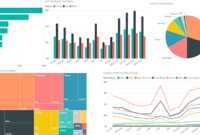Real-time BI opens the door to instant data-driven decision-making, revolutionizing how businesses operate and make critical choices in the digital age. Explore the dynamic world of Real-time BI and discover its transformative potential.
Definition of Real-time BI

Real-time Business Intelligence (BI) refers to the use of data analytics tools and techniques to provide immediate insights and analysis on business operations as data is being generated. It allows organizations to make informed decisions quickly based on up-to-the-minute data.
Importance of Real-time BI
Real-time BI is crucial in today’s fast-paced business environment where decisions need to be made swiftly to stay competitive. By providing real-time insights into key performance indicators, organizations can identify trends, detect anomalies, and respond promptly to changes in the market or internal operations.
- Real-time monitoring of sales data can help retailers adjust pricing strategies on the fly to maximize profits.
- Manufacturing companies can optimize production processes by analyzing real-time data on equipment performance and inventory levels.
- Financial institutions can detect fraudulent activities in real-time, preventing potential losses.
Examples of Industries that Benefit from Real-time BI
Real-time BI can benefit various industries, including but not limited to:
- Retail: Real-time BI helps retailers track customer behavior, inventory levels, and sales performance to make informed decisions on pricing, promotions, and product placements.
- Healthcare: Healthcare providers can use real-time BI to monitor patient outcomes, operational efficiency, and resource utilization to improve patient care and optimize operations.
- Telecommunications: Telecom companies can analyze real-time data on network performance, customer usage patterns, and market trends to enhance service quality and customer satisfaction.
Characteristics of Real-time BI
Real-time Business Intelligence (BI) tools offer several key features that set them apart from traditional BI systems. These characteristics play a crucial role in enabling organizations to make data-driven decisions quickly and efficiently.
Real-time BI tools are designed to gather, process, and analyze data in real-time, providing up-to-the-minute insights for decision-making. This is achieved through the continuous extraction, transformation, and loading (ETL) of data from various sources, such as databases, applications, and sensors.
Data Gathering and Processing
Real-time BI tools leverage technologies like data streaming and in-memory processing to gather and process data instantaneously. Data is collected from multiple sources in real-time, eliminating the need for manual data entry or batch processing. This ensures that decision-makers have access to the most current information at all times.
- Real-time data streaming: Data is streamed continuously from source systems to the BI tool, allowing for immediate analysis and visualization.
- In-memory processing: Data is stored in memory for rapid retrieval and processing, enabling quick response times for queries and reports.
- Automated ETL processes: Data extraction, transformation, and loading processes are automated to ensure that data is always up-to-date and accurate.
Comparison with Traditional BI Systems
Real-time BI systems differ from traditional BI systems in several ways, primarily in terms of speed, agility, and responsiveness. Traditional BI systems often rely on batch processing and scheduled updates, resulting in delays in data availability and analysis. In contrast, real-time BI tools deliver instant insights and enable organizations to react quickly to changing business conditions.
- Speed and agility: Real-time BI tools provide immediate access to data, allowing organizations to respond rapidly to market trends and customer needs.
- Responsiveness: Real-time BI systems enable proactive decision-making by alerting users to critical events or anomalies as they occur.
- Continuous monitoring: Real-time BI tools offer continuous monitoring of key performance indicators (KPIs) and metrics, ensuring that stakeholders have real-time visibility into business operations.
Implementation of Real-time BI
Implementing a Real-time Business Intelligence (BI) system requires careful planning and execution to ensure successful deployment. Below are the key steps involved in implementing a Real-time BI system, along with challenges faced and best practices to overcome them.
Steps in Implementing Real-time BI
- Assess Business Needs: Begin by identifying the specific business objectives and KPIs that the Real-time BI system will address.
- Choose the Right Tools: Select appropriate BI tools and technologies that can handle real-time data processing and analysis efficiently.
- Data Integration: Integrate data from various sources in real-time to enable accurate and up-to-date reporting and analytics.
- Develop Data Models: Create data models that support real-time analysis and visualization of data.
- Implement Real-time Monitoring: Set up real-time monitoring dashboards to track key metrics and alerts in real-time.
- Training and Adoption: Provide training to users on how to use the Real-time BI system effectively and encourage adoption across the organization.
Challenges Faced During Implementation
- Data Quality Issues: Ensuring data accuracy, consistency, and completeness in real-time can be challenging.
- Integration Complexity: Integrating data from multiple sources in real-time requires a robust architecture and careful planning.
- Performance Optimization: Real-time BI systems need to be optimized for performance to handle large volumes of data and deliver insights quickly.
- Change Management: Overcoming resistance to change and ensuring user adoption of the new system can be a significant challenge.
Best Practices for Successful Deployment, Real-time BI
- Engage Stakeholders: Involve key stakeholders from different departments in the implementation process to ensure alignment with business goals.
- Pilot Testing: Conduct pilot testing of the Real-time BI system with a small group of users to identify and address any issues before full deployment.
- Continuous Monitoring and Improvement: Regularly monitor the performance of the Real-time BI system and make adjustments as needed to optimize its functionality.
- Data Governance: Establish strong data governance practices to maintain data quality and integrity in real-time BI reporting.
Benefits of Real-time BI

Real-time Business Intelligence (BI) offers a wide range of benefits that can significantly impact an organization’s decision-making processes, operational efficiency, and overall business performance.
Improved Decision-making
Real-time BI provides immediate access to up-to-date data and insights, allowing decision-makers to make informed decisions quickly. This timely information enables organizations to respond promptly to changing market conditions, customer preferences, and emerging trends.
Enhanced Operational Efficiency
By leveraging Real-time BI tools, organizations can streamline their operations, identify bottlenecks, and optimize processes in real time. This leads to improved productivity, reduced costs, and better resource allocation across various departments.
Increased Business Performance
Implementing Real-time BI can have a direct impact on overall business performance by enabling organizations to identify opportunities for growth, mitigate risks, and capitalize on market trends swiftly. With access to real-time analytics, businesses can drive revenue growth, enhance customer satisfaction, and stay ahead of competitors in today’s fast-paced business environment.
Real-time BI Tools and Technologies

Real-time Business Intelligence (BI) requires robust tools and technologies to enable organizations to make informed decisions based on up-to-the-minute data. Let’s explore some popular tools and technologies used for Real-time BI and discuss their role in enhancing data analytics capabilities.
Popular Tools and Technologies for Real-time BI
- Tableau: Tableau is a powerful data visualization tool that allows users to create interactive dashboards and reports in real-time, enabling decision-makers to quickly analyze data and gain insights.
- Power BI: Microsoft Power BI is another widely used tool for Real-time BI, offering features such as real-time dashboards, data connectivity, and AI-driven insights.
- Sisense: Sisense is known for its ability to handle large datasets and provide real-time analytics through its in-chip technology, making it a popular choice for organizations requiring instant data insights.
Comparison of Different Real-time BI Platforms
- Tableau vs. Power BI: Both Tableau and Power BI are popular choices, but Tableau is often preferred for its advanced data visualization capabilities, while Power BI is praised for its seamless integration with other Microsoft products.
- Sisense vs. Looker: Sisense and Looker are both strong contenders in the Real-time BI space, with Sisense offering powerful in-chip analytics and Looker excelling in data modeling and exploration.
Role of AI and Machine Learning in Real-time BI
AI and machine learning play a crucial role in enhancing Real-time BI capabilities by automating data analysis, identifying patterns, and predicting future trends. These technologies enable organizations to process vast amounts of data in real-time, providing actionable insights for faster decision-making and competitive advantage.
In conclusion, Real-time BI emerges as a game-changer in the realm of business intelligence, offering unparalleled speed and accuracy in decision-making processes. Embrace the power of real-time insights to stay ahead of the competition and drive success in your business endeavors.
When it comes to analyzing data and making informed decisions, businesses rely on Business Intelligence tools to gather, interpret, and visualize information. These tools play a crucial role in helping organizations understand market trends, customer behavior, and internal operations.
Implementing effective BI solutions can streamline processes, improve efficiency, and ultimately drive growth. By leveraging these solutions, companies can access real-time data insights that enable them to make strategic decisions based on accurate information.
With the rise of big data, businesses are increasingly turning to Data-driven decisions to stay competitive. By analyzing large volumes of data, organizations can identify patterns, trends, and opportunities that inform their decision-making processes and drive success.




